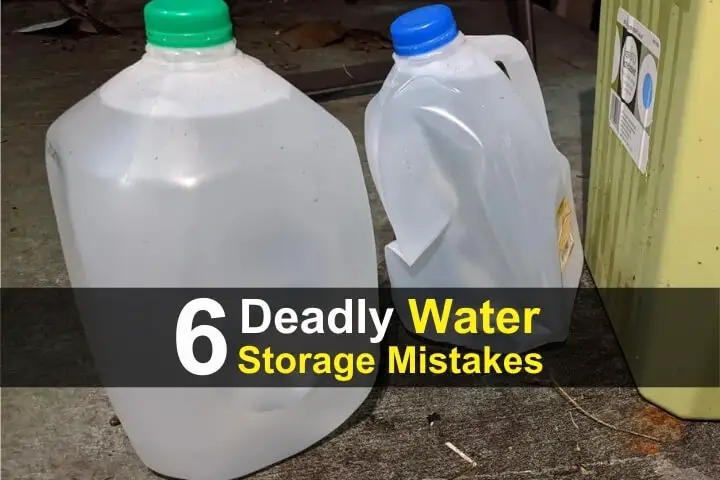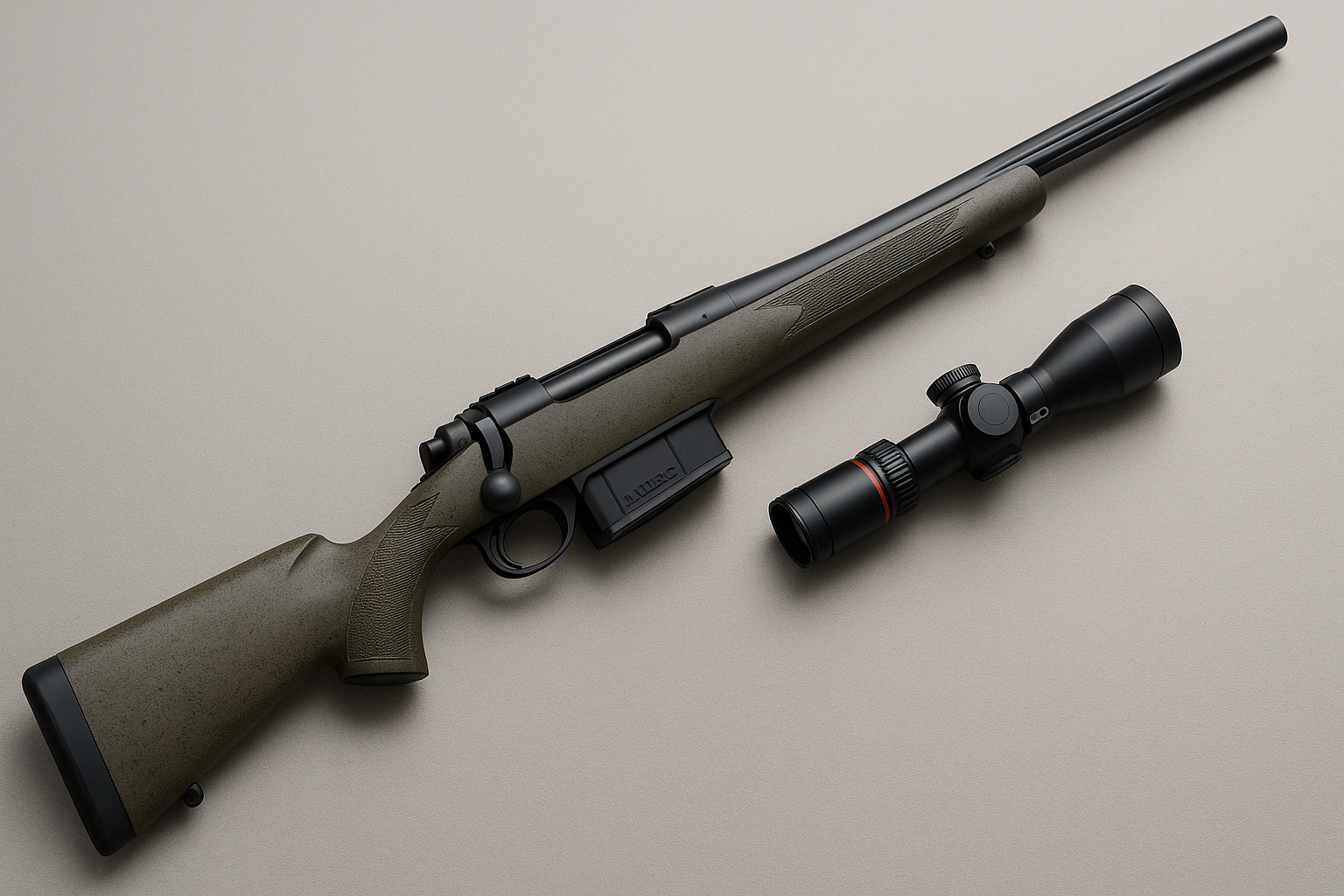Estimated reading time: 9 minutes

Water is probably the most important resources we have, yet most people take it for granted. One of the first things you learn about when becoming a prepper is the importance of water. If you want to survive any disaster, it’s crucial that you have a well-thought-out water plan.
A great water plan should consist of four parts: 1) Having access to water or knowing how to find it. 2) Having a plan to transport water if necessary. 3) Having the ability to filter and purify water. 4) Having a proper water storage plan.
In this article, we will be concentrating on the last part, storing water, because this is where most people mess up. There are a lot of simple water storage mistakes that people make, and some of them are deadly.
Want to save this post for later? Click Here to Pin It On Pinterest!
Deadly Water Mistakes
Unfortunately, storing potable water isn’t as simple as filling up a container and setting it on a shelf somewhere, hoping that it will be in perfect condition when you need it. There are certain steps that need to be taken to ensure the water going into the container is free of contaminants and stays that way once in a proper storage container.
This article will cover 6 primary mistakes when storing water:
- Not Filtering Rainwater
- Using Too Much Bleach
- Using The Wrong Containers
- Storing Tainted Water
- Storing In The Wrong Storage Conditions
- Not Rotating Water Supplies
1. Not Filtering Rainwater
A few years ago, scientists discovered that rainwater is now unsafe to drink due to high levels of PFAS (also known as “forever chemicals”). Most preppers don’t bother to filter PFAS out of their water, and you don’t have to if you don’t want to. After all, PFAS are everywhere nowadays and it’s almost impossible to avoid them.
However, if you do want to remove them from your rainwater, there are a few different methods including GAC filters and reverse osmosis filters. There are also PFAS tests that show you if your filters are working.
But even if you’re not worried about forever chemicals, you still need to purify your rainwater. Most people don’t collect the rainwater from the sky directly into the storage container and seal it. Almost always, a rain catchment system of some kind is used that will make the water unclean.
For example, rain falls onto a rooftop where it then flows into a gutter system. From there it goes down a pipe and ends up in a large collection container of some kind before it is moved to a storage container. All of those surfaces the rain travels across are unclean to some degree or another and the rainwater picks up contaminants as it moves across them.
Also, allowing rainwater to sit for hours or days in a large collection container that is unsealed, provides ample time for the growth of microorganisms.mThe same can be said for a simple tarp that is set up because you don’t know what is on the tarp’s surface.
That’s why you should always filter and purify rainwater before storing it.
2. Using Too Much Bleach
A very common additive used to make water safer to drink is sodium hypochlorite, or as most people know it, household bleach. The general rule of thumb is to add eight drops of six percent sodium hypochlorite per gallon of water.
One thing to keep in mind if you are using tap water in storage containers is that many municipalities use sodium hypochlorite in their water treatment process. So, you don’t want to be adding too much if it’s already been added to your tap water. A little bit of bleach added to water is deemed okay and acceptable, but adding too much may lead to poisonous levels.
“When lower concentration household bleach is swallowed, irritation of the mouth, throat, and gastrointestinal tract can occur. This can result in nausea, vomiting, and abdominal pain. Consumption of concentrated bleach products can lead to permanent gastrointestinal damage and may result in death,” according to www.posion.org.
Every water treatment plant should send out a yearly report about the quality of the water in your area with a breakdown of the levels of chemicals used and contaminants present. If you don’t receive these reports, the information should still be available to the public by either calling local officials or by getting on your municipality webpage to access the water reports.
3. Using The Wrong Containers
Another mistake that has the potential to be deadly is storing water in the wrong kind of container. Unless you are in a true survival situation, it’s a bad idea to use just any old container you can find for water storage.
If the container is not made from food-grade material or specifically made for holding water, it should not be used for water storage. This is because some contaminants cannot be completely washed out of certain containers and non-food grade containers can leech other harmful chemicals into your water supply.
There are a lot of options available today to buy second-hand items and that includes water storage containers. It may be tempting to go this route as brand new containers can be rather pricey, but you should be extremely cautious when pursuing this route.
The reason is that when you buy a second-hand container, you really don’t know exactly what was stored in it and there could be lingering hazards that may contaminate your drinking water. Overall, the option of buying second-hand containers is not advised unless you can say you trust the seller of that container with your life.
The best kind of containers to use for your water storage are ones that are brand new, can be tightly sealed, and are made from food-grade materials, such as polyethylene plastics #1, #2, or #4. The container should also be opaque or colored, not clear and see through. This helps to reduce the amount of light reaching the inside that could otherwise promote the growth of microorganisms.
If you use a container that isn’t made from food grade materials, you are running the risk of harmful compounds leaching into your water supply. The effects of which may not be seen right away but there will be negative effects.
4. Storing Tainted Water
As we mentioned earlier, storing water isn’t as simple as grabbing a random container, filling it up with tap water, and setting it on a shelf, even though it’s likely many people use this method. There are several things that can go wrong with storing water like this and while we will discuss those issues in a bit more detail in later sections, let’s broadly go over them now.
Because many food grade and water storage containers can be expensive, it’s common for someone to want to grab an empty container from their kitchen and use that for storing water in. Like an empty milk jug or orange juice jug.
If you have ever tried to rinse containers like these out, you know that no matter how much you wash it, there is always a lingering odor from what was previously in it. Even though these containers are made of food grade materials, those lingering remnants could later promote the growth of microorganisms, which can make you sick.
Most people now accept that a lot of tap water really isn’t all that great for us. It’s deemed safe for consumption because any levels of harmful contaminants are within “acceptable limits.”
Other than the chemicals used at water treatment facilities, it’s entirely possible that tap water may contain a host of other chemicals from industrial use that can’t be completely removed. Not only are these chemicals hazardous by themselves but they may have the potential of interacting with the container itself and cause leaching of additional harmful compounds.
Even after tap water has been treated at a water treatment plant, it’s worth considering the possibility of it being contaminated between the plant and your home. For example, what if an underground pipe has a minor hole in it? This could lead to unsavory compounds seeping into a “safe” water supply.
Many common kitchen containers are also transparent or opaque, which allows light to get inside and since they are not considered long term storage containers they may not have “perfect” seals on them. Allowing light and air to reach the inside of a water storage container only helps to promote the growth of microorganisms.
In the end, harmful chemicals and microorganisms that we cannot see in our water, can easily make their way into a water storage container that isn’t properly prepared or stored. Both of which may make you ill, severely ill, or even lead to death.
5. The Wrong Storage Conditions
After you have filtered, purified, and put the water into a proper container that can be sealed, it’s time to store it. The best storage conditions for water are the same as the best storage conditions for your food.
You want to store your sealed water containers in a cool, dark, and dry location out of the reach of sunlight. Warm or excessively hot conditions, as well as direct sunlight, can degrade the integrity of a water container and will also promote the growth of microorganisms.
Also, be sure you aren’t storing your water directly on the floor. If you place it on a concrete floor, the containers can absorb chemicals which leach through into the water. There are also greater temperature fluctuations on concrete, which can warp and weaken the containers. And finally, there’s a greater risk of mold, mildew, and structural damage to the container on a hard surface.
Instead, place your containers on a pallet, cinder blocks, or some kind of sturdy shelving.
6. Not Rotating Water Supply
The last item to talk about is water rotation schedules. Rotating your water supplies is no different than rotating your food supply with the idea in mind of FIFO (first in, first out) The general rule of thumb that many people follow is to rotate and change out your water supply every six months.
Rotating your water isn’t actually necessary if it has been properly filtered, purified, and sealed. However, sometimes bad things just happen, so rotating your water supplies every six months or so will help to ensure that the water you have stored remains as fresh as possible.
Conclusion
Hopefully, this article has helped to answer some of your questions about water storage or will help you to correct any deficiencies you may not have been aware of with your water storage.
Interestingly, this article can also be tied to another common question, which is, “How long can I safely store water?” or “Does water go bad?”
Technically, water doesn’t really go bad as long as it is filtered, purified, and stored properly. It’s only when water is stored improperly that it may become contaminated by chemicals or the growth of microorganisms. By following proper water storage techniques, the water you store should last a very long time.
Like this post? Don’t Forget to Pin It On Pinterest!
You May Also Like:
Read the full article here






